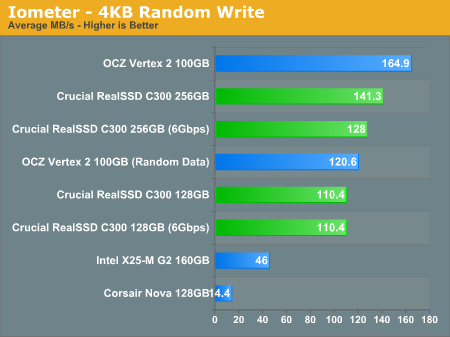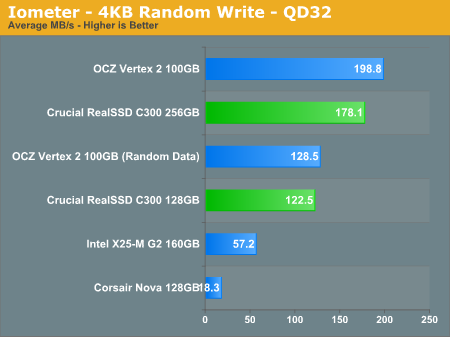The SSD Diaries: Crucial's RealSSD C300
by Anand Lal Shimpi on July 13, 2010 12:39 AM ESTRandom Read/Write Speed
The four corners of SSD performance are as follows: random read, random write, sequential read and sequential write speed. Random accesses are generally small in size, while sequential accesses tend to be larger and thus we have the four Iometer tests we use in all of our reviews.
Our first test reads/writes 4KB in a completely random pattern over an 8GB space of the drive to simulate the sort of random access that you'd see on an OS drive (even this is more stressful than a normal desktop user would see). I perform three concurrent IOs and run the test for 3 minutes. The results reported are in average MB/s over the entire time.

The C300 offers by far the best random read performance of any SSD we’ve tested. This applies to both the 256GB and 128GB versions of the C300, and while operating on a 3Gbps SATA controller. There’s a roughly 38% performance advantage over the SandForce based OCZ Vertex 2 and Intel X25-M G2. There's hardly any benefit to moving to a 6Gbps controller here as the transfer rates don't even saturate 1.5Gbps SATA.

Random write speed is similarly high, but not quite as dominant. Intel’s X25-M G2 simply shows its age here. You must keep in mind that the G2 was a mild update to the original X25-M, an architecture that was designed back in 2006 - 2007 and first sold in 2008. The X25-M G2 is simply an old architecture by today’s standards. While it makes a great value SSD, there should be no surprise that a C300 is over twice as fast in our 4KB random write test.
It’s the SandForce comparison that’s less cut and dry. By default Iometer uses data that is highly repetitive in nature. While our random test writes data to random addresses, the contents of the data itself isn’t random. The Vertex 2’s SF-1200 controller recognizes the obvious pattern in the data and just doesn’t write most of it to the drive. This is the best case scenario for the SandForce controller architecture. Now it’s absolutely a realistic workload, but not always likely.
Using a custom build of Iometer we are able to write completely random data to the drive. This data can’t be compressed and effectively defeats SandForce’s write amplification reduction algorithm. I’d argue that this scenario is even less likely than one where the data is nearly infinitely compressible, at least for a desktop user. SandForce claims that an install of Windows 7 + Office 2007 requires less than half the writes on one of its drives compared to a traditional SSD.
The point here is that while I can present performance in both cases, the real world write performance of the Vertex 2 and other SandForce drives will be somewhere in between the two numbers you see represented in the chart above. And compared to the 128GB C300, I’d say it’s likely that the Vertex 2 has the advantage in 4K random write performance. The 256GB drive improves performance enough where I’d be comfortable saying it’s probably a tossup between the two.
The 6Gbps performance is an odd story to tell here. The 128GB drive actually performs the same regardless of whether or not it's on our 6Gbps controller, however the 256GB drive takes a performance hit going to the 6Gbps controller (HighPoint Rocket 620, using the Marvell 88SE9128 controller similar to many motherboards). This is purely a fault of the controller and unfortunately one of the tradeoffs you'll have to make with the move to 6Gbps. It's very difficult to beat Intel's own SATA controller.
Many of you have asked for random write performance at higher queue depths. What I have below is our 4KB random write test performed at a queue depth of 32 instead of 3. While the vast majority of desktop usage models experience queue depths of 0 - 5, higher depths are possible in heavy I/O workloads:

While the 128GB C300 is slower than the 100GB Vertex 2, the 256GB version hangs with the SandForce posterchild. If you need the capacity, the 256GB C300 is easily a good performer even at high queue depths.










51 Comments
View All Comments
strikeback03 - Tuesday, July 13, 2010 - link
Really? I have 3 computers, and can see a use for the 30-40GB, 60-80GB, and 100+GB size drives depending on which system I am thinking of. For my HTPC, a small drive would be fine, all it holds is the OS. For my desktop, I have an 80GB X25G2, as IMO a smaller drive would be iffy when 2 operating systems are installed on the drive, and allowing for extra spare area. For my laptop I wouldn't consider anything under 100GB, as I don't want to have to carry a separate external drive to store stuff to.erple2 - Tuesday, July 13, 2010 - link
I'll second that - my laptop has the 160 gig Intel G2 drive in it because I have installed slightly more than the OS on it (a few steam games + WoW = need more than 80 gig).I don't need more than about 120-160 gigs on my laptop (that's what my home server is for). My desktop would be in the same boat - I'd need enough "space" to install some large applications on it plus the OS.
I've heard people recommend that you should install applications on spindle drives, but the reality is that some of those applications are very slow loading on a spindle drive.
Personally, I don't care if my OS takes 5 minutes to boot. I almost never shut down anyway.
neoflux - Tuesday, July 13, 2010 - link
Fantastic article as always, Anand. Informative, investigative, and conclusive. I couldn't ask for anything else ( other than the funds to purchase a Vertex 2 :P ).Slaimus - Tuesday, July 13, 2010 - link
With such a large DRAM cache, is there greater risk of data corruption when there is a power outage or power supply failure?Anand Lal Shimpi - Tuesday, July 13, 2010 - link
Crucial claims to store very little user data in the external DRAM, it's mostly to give the firmware room to store mapping tables and history data to make better decisions about how to organize future writes.Take care,
Anand
GourdFreeMan - Tuesday, July 13, 2010 - link
Have you ever actually put this to the test, though?Intel claims they do the exact same thing with their DRAM, yet I have had applications that were not in use become corrupt after a sudden power loss (i.e. bluescreen after resuming from hibernation, cat depressing laptop power button) on my Intel G2 drives. The mechanical drives that were in the exact same system prior to being replaced by SSDs only lost minimal amounts of data (and typically only the data in use at the time) under the exact same power loss scenarios.
Echo147 - Tuesday, July 13, 2010 - link
My first SSD - And it couldn't be picked up after just 5 hours. Pretty crushed :sIt'd been shipped with Firmware 0001 which I'm guessing was a large oversight by Crucial or the retailer. I wasn't about to go flashing a £500 drive, so it's in RMA as we speak.
Will be waiting for Intel's 25nm offerings before dipping my burned toes again...
greggm2000 - Tuesday, July 13, 2010 - link
Anand,Are there any plans to test these drives in RAID configuration? You've already done so with Intel's cheapest value drive, but for those of us who are considering in the higher end drives, it would be interesting to know such things as will a pair of Crucial RealSSD 128GB drives on SATA outperform a single 256GB on SATA 6Gb... or even how well 4 of the 64GB drives compare as well. Also, how do the Sandforce drives compare in RAID to the others.
Thanks! Great article as always!
mckirkus - Tuesday, July 13, 2010 - link
Just to get a sense of what is used by most humans (hard drives, not VRaptors).Alkapwn - Tuesday, July 13, 2010 - link
Do SandForce controllers suffer when BitLocker is enabled? I'm guessing there would be less predictable data patterns for it's controller to use, and thus might be slower? Would that then solidly put the lead in Crucials favor?